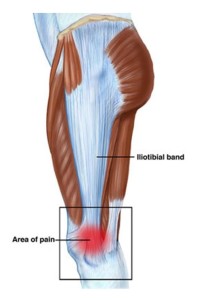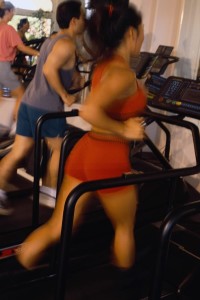Why am I getting this pain on my knee when I run?
On this page we tackle a common overuse injury that inflicts up to 22% of all runners – the ITB friction syndrome.
The symptoms are generally pain at the outside of the knee that can radiate down the side of the calf. The onset of knee pain is normally after a period of running and this time this will generally shorten as the condition progresses. If it is really bad then there is pain at rest and pain with walking.
The ITb or illiotibial band is a large dense fascia that originates at the top of the pelvis and attaches below the knee. Its function is to allow for the pull of the hip muscles on the lower leg. It has a thickening in the region that passes over the lateral aspect of the knee and has a region of compression against the knee when the knee is bent at 30 degrees with normal movement. This angle corresponds to the angle of the knee generally when the foot hits the ground with running and the hip muscles are working to decelerate the leg on heel strike.
So what brings on this condition?
The factors that are responsible for all lower leg overuse injuries include either extrinsic or intrinsic factors or a combination of both. 
Extrinsic factors include;
- Sudden increase in the load of running
- Inadequate warm up
- Poor running shoe selection or worn out running shoes
- Running on uneven surfaces especially with a cambre so there is increased tension in the ITb
Intrinsic factors include;
- Poor gluteal muscle strength that allows for poor lower leg alignment especially for the knee to collapse inwards
- Foot pronation
- Poor abdominal core stability that affects the stability of the pelvis and hips
- Tight quadriceps (front of leg muscles) resulting in altered muscle imbalance
What can you do about it?
The first thing is to listen to the symptoms and try not to run through it.
We have had some success with various taping techniques to unload the ITb or to correct the biomechanics but most of our clients need to decrease their running or even have a lay off to work on the underlying factors responsible for this condition.
- The first step with any injury is to start icing the side of the knee.
- Next step is to start to release the ITb via massage and foam roller which helps to release the tension in the band.
- Strengthening the Gluteals and the Quads is always needed.
Your All Care Physiotherapist can provide an assessment on the factors that have caused the condition in the first place and start the process of recovery and getting you back on track with your running.
Treatment will include;
- Local ultrasound to reduce the soreness and inflammation at the knee
- Releases of tight leg structures including the ITb and Quads
- Dry needling of the muscles around the ITb to release tightness
- Assessment of your lower leg biomechanics to see what needs to be corrected
- Assessment of your running shoes to see if they are the right ones for you
- Prescription of orthotics if needed
- Gluteal and Quadriceps strengthening exercises
- Taping to unload the ITb
- Advice on how to return to running gradually and build up your training
Here is a video of a common ITB stretch done with a foam roller
So if pain on the side of the knee is interfering with your running then seek an assessment with your Physiotherapist at All Care Physiotherapy to get back on track with your training.


